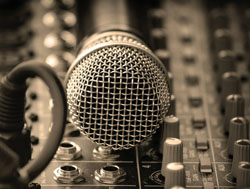An excerpt from The Recording Engineer’s Handbook.
Basic tracks (sometimes called just “basics” or “tracking”) refers to the recording of the rhythm section, and is the foundation for any other parts that are to be recorded afterward.
What that means is that if there’s something faulty in the recording of the basics, it’s usually going to cost time and money to fix it later.
That’s why it’s essential that the basic track recording is as good as it can be both sound and performance-wise.
Basic tracks can encompass any of the following:
—The entire band, regardless of the number of pieces
—The rhythm section only (drums, bass, guitar, keys)
—Drums, bass and guitar
—Drums, bass and keyboards
—Drums and bass only
—Drums and keys only
—Drums and guitar only
—Drums only
—Loops and another instrument
All of the above usually also have a guide or “scratch” vocal recorded at the same time as well to at least provide cues to the various sections of the song. While programming the rhythm section might also qualify as a “basic” session, it doesn’t require any microphones or a scratch vocal, so we’ll leave it out of the discussion.
It’s also not uncommon for the drums and several other instruments to play during the basics, with the idea of only capturing a great drum track, then replacing the other instrument tracks with better sounding and performed overdubs.
Preparing For The Session
One of the keys to a successful basic tracking session is the preparation made beforehand, but before you can prepare for the recording you need some essential information first. Here’s the minimum that you must determine in advance of the session. This will usually be provided by the producer, artist or band leader, and assumes that you’re unfamiliar with the act.
—What type of music will be recorded?
—How many songs do you expect to record?
—Who are the musicians (If you know some of them it might affect your setup)?
—Who’s the producer (if you’re not talking to him already)?
—What time does the session begin? Does that mean the downbeat of recording or when the musicians are expected at the studio to load in?
—How long do you expect the session to go?
—How many musicians will be playing at once?
—What’s the instrumentation?
—How large is the drummer’s kit? How many toms will he be using?
—Will the guitarist(s) be using an acoustic or electric?
—What kind of amps will the guitar player(s) and bass player be using?
—Do any of the players expect to use house gear like drums, guitar amps, or keyboards?
—How many cue mixes will be required?
—Will there be a scratch vocal tracked at the same time?
—Will they bring any special outboard gear or mics that they’d like to use?
—Will they be tracking to loops?
—Do they require any particular instruments, amps or effects?
Determining the above before the musicians hit the studio can go a long way to a quick and easy setup and an efficient session.
TIP: Don’t ask for the setup information too far in advance since much can change by the day of the session. Getting the info the day before the session is usually sufficient.
Setting Up A Talkback Mic
One of the things that engineers, producers and musicians all hate during a tracking date is when they find it difficult to communicate with one another. Usually it’s easy for the control room to speak with the musicians, but it’s not easy to hear the musicians speak to the control room through the open mics that are used on the session, since they’re adjusted for the louder playing levels instead of talking.
That’s why it’s essential to use at least one dedicated talkback mic out in the studio with the players so you can always hear what’s happening on that side of the glass.
The type of mic used really doesn’t matter, although an omni set in the middle of the studio can work quite well, Sometimes a second talkback mic is also added in a large studio. In fact, some engineers go as far as to set up a dedicated talkback mic for each musician if it’s only the four piece rhythm section recording.
Regardless of how many mics you use, the talkback mic will make communication between the control room and the studio a lot easier, and keep the musicians a lot happier as a result.
TIP: Make sure to mute the talkback mic when the band is playing. It will probably sound tremendously trashy and distorted, since it’s set up for people talking and not playing.
Bobby Owsinski is an author, producer, music industry veteran and technical consultant who has written numerous books covering all aspects of audio recording. For more information be sure to check out his website and blogs. Get the second edition of The Recording Engineer’s Handbook here.





















